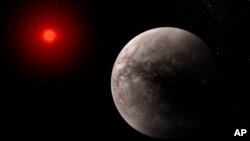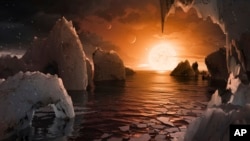The Webb Space Telescope has found no evidence of an atmosphere on one of the seven rocky, Earth-sized planets orbiting a nearby star.
Scientists said Monday that could mean the other planets in that system also lack atmospheres. Some of the planets are believed to be the right distance from the star to support water and possibly life. Scientists call this area the habitable zone.
Sara Seager is a scientist with Massachusetts Institute of Technology (MIT). She was not part of the study but spoke to the Associated Press. She said in an email, “This is not necessarily a bust” for the other planets. And she added, “But we will have to wait and see.”
The planets orbit a star forming a system known as TRAPPIST-1 after the telescope that identified the planets. It is rare that seven planets about the size of our Earth would orbit the same star. Three of those planets are in the star’s habitable zone.
TRAPPIST-1 is only 40 light-years away. A light year is the distance light travels in one year. That is relatively close to our own solar system and a reason why scientists are interested in it.
The NASA-led team reported little if any atmosphere exists on the innermost planet in the system. The results were published Monday in the journal Nature.
Thomas Greene of NASA’s Ames Research Center is the lead researcher of the study. He said the lack of an atmosphere would mean no water and no protection from space radiation.
As for the other planets orbiting in the TRAPPIST-1 system, “I would have been more optimistic about the others” having atmospheres if this one had, Greene said in an email.
MIT’s Seager said that if rocky planets orbiting the kind of star in the TRAPPIST-1 system, a very cool red dwarf, “do turn out to be a bust, we will have to wait for Earths around sun-like stars, which could be a long wait.”
The TRAPPIST-1 system’s innermost planet receives four times as much solar radiation as Earth gets from the sun. Greene noted that it is possible that extra energy is why there is no atmosphere. His team said temperatures there reached 230 degrees Celsius on the side of the planet that is always facing its star.
The Webb is the largest and most powerful space telescope. By using Webb, the American and French scientists were able to measure the change in brightness as the innermost planet moved beyond its star. They then could estimate how much infrared light was sent off from the planet.
The change in brightness was very small since TRAPPIST-1 is more than 1,000 times brighter than this planet. The European Space Agency said Webb’s detection of this light is itself a very large step.
More observations are planned not only of this planet, but the others in the system.
Taylor Bell of the Bay Area Environmental Research Institute took part in the study. He said looking at the innermost planet in another kind of light could uncover an atmosphere much thinner than our own, although it seems unlikely it could survive.
Michael Gillon of the University of Liege in Belgium was part of the team that discovered the first three planets in 2016. He did not take part in the latest study. He said further research could still uncover an atmosphere even if it is not like Earth’s.
Gillon said scientists are entering new areas of research with rocky planets outside our solar system. Scientists' understanding of rocky planets is based on the four in our solar system: Mercury, Venus, Earth and Mars.
Webb was launched in late 2021 to an observation point 1.6 million kilometers away. It has taken over for the Hubble Space Telescope, which has orbited Earth for more than 30 years.
In the past, Hubble and the Spitzer Space Telescope searched the TRAPPIST-1 system for atmospheres but did not find any.
Julien de Wit of MIT was not involved in the study. But, he said, “It is just the beginning, and what we can learn with the inner planets is going to be different from what we can learn from the other ones.”
I’m Gregory Stachel. And I'm Jill Robbins.
Marcia Dunn reported this story for The Associated Press. Gregory Stachel adapted it for VOA Learning English.
___________________________________________________________________
Words in This Story
bust – n. a complete failure
cosmic – adj. of or relating to the universe or outer space
optimistic – adj. having or showing hope for the future
detect – v. to discover or notice the presence of (something that is hidden or hard to see, hear, or taste)
___________________________________________________________________
What do you think of this story?
We want to hear from you. We have a new comment system. Here is how it works:
- Write your comment in the box.
- Under the box, you can see four images for social media accounts. They are for Disqus, Facebook, Twitter and Google.
- Click on one image and a box appears. Enter the login for your social media account. Or you may create one on the Disqus system. It is the blue circle with “D” on it. It is free.
Each time you return to comment on the Learning English site, you can use your account and see your comments and replies to them. Our comment policy is here.










Forum